Good dog paw care plays a role in the overall health of your furry best friend. Taking care of canine feet is just as important as maintaining your own foot health. While dog paws are tough, they’re every bit as vulnerable as human feet, and like ours, they need to be taken care of and pampered.
Paws take a beating every day, from carrying the weight of the body to treading over harsh surfaces. They require grooming and maintenance to keep them healthy and strong. As a dog parent, you want your hound to feel their best every day and by keeping nails and paw pads in top shape, you’re helping him do just that!
Check out these 5 must-know tips for taking care of your dog’s paws.

1. Trimming
Keep nails in shape.
If a dog’s nails are click, click, clicking when she walks or get snagged easily, then she is in need of a clipping. Dog nails should barely skim the ground. Most vets offer this service if the owner is too anxious to perform the trimming themselves or the dog is unwilling to have it done. Though some dogs balk at having their nails clipped, its an important part of good dog paw care.
Groom hair between dog toes.
The hair in between the pads does cause painful matting if not trimmed regularly. Comb hair out and trim so they’re even with the pads. Check for pebbles, splinters, or other debris while trimming.
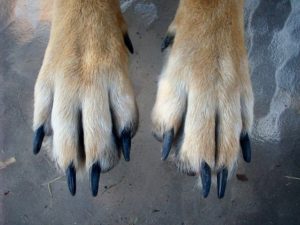 Keeping nails at an appropriate length is part of good dog paw care.
Keeping nails at an appropriate length is part of good dog paw care.
Need tips for clipping dog nails at home? Check out these 9 Expert Tips To Make Nail Trims Easier On Your Dog.
2. Inspect dog paw pads.
Moisturize paw pads to avoid cracking.
Pads do crack and bleed if they get too dry. Don’t use human lotion on the dogs’ pads though, it may soften pads too much and lead to more issues. Instead, look into pad moisturizers specifically designed for a dog’s dried out paws. While rubbing in the lotion, pamper your pup with a paw massage by rubbing between the pads and up in between each toe. She will love you even more for the TLC.
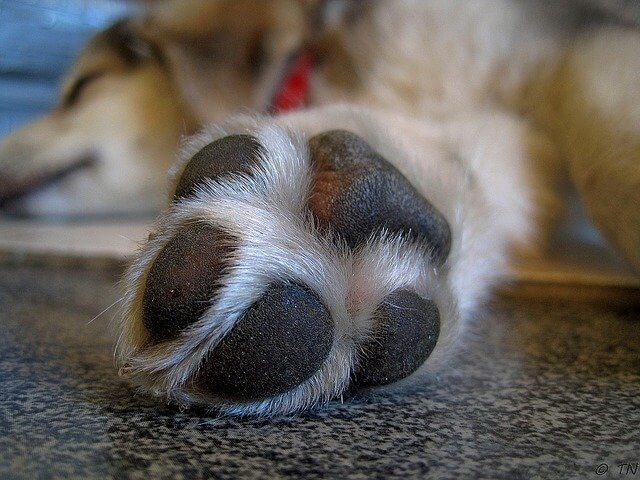
Swollen paw pads need medical care.
Paw pads can swell for a number of reasons and most require some level of care to ease pain and inflammation:
- Injury caused by a foreign object
- Insect or spider bites
- Allergies
- Illness and/or Infections
If your dog has painful, swollen paw pads, contact your vet.
RELATED: Are Your Dog’s Paw Pads Hairy? It Might Be Hyperkeratosis
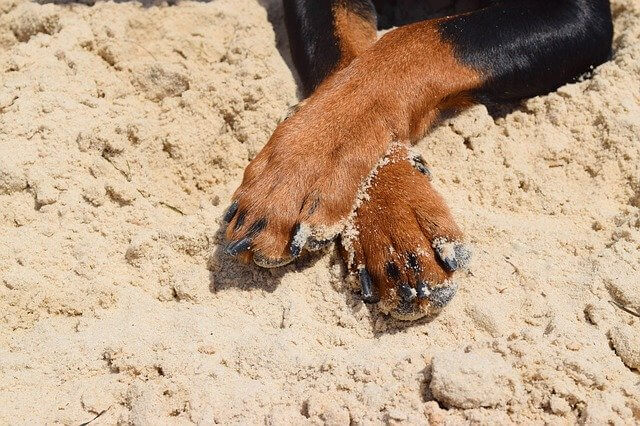 Fun in the sun is great, but don’t let dog paw pads get burnt on hot surfaces.
Fun in the sun is great, but don’t let dog paw pads get burnt on hot surfaces.
3. Summertime Dog Paw Care
Dogs paws burn on hot surfaces.
Dogs’ paws feel the heat as much as humans’ do on the bottom of their feet. Keep this in mind while out walking during the heat of the summer. To avoid blistering and burning, avoid walking on hot surfaces (such as parking lots or sand). If blistering or burning occurs, wash with antibacterial soap and loosely wrap with gauze.
Avoid treading over trash when out walking.
When the summer season hits, more people take to the outdoors. A great thing for dogs and humans alike, but sadly, some people leave trash in their wake. Look out for refuse that could injure dog paws.

4. Wintertime Dog Paw Care
Lotion for dog paws exposed to the cold.
Excessive exposure to cold weather could cause paw pads to dry out. This will lead to pads becoming chapped and cracking. Splitting in the fatty tissue of the paw pads can also cause bleeding and pain. Using a dog paw moisturizer will help soothe winter-worn feet.
Be aware of winter chemicals.
Another thing to keep in mind during the long, cold winter months is that lots of people use salt, de-icers and other items to melt ice off of sidewalks. This could be toxic to dogs who like to lick their paws or could even cause burns on their feet. When coming home from a daily walk, either wipe down or rinse the paws with warm water to wash away any chemicals they may have picked up. Another alternative is to slather the dog’s paws with a pet-safe paw balm before a walk, which will keep salt from getting on the pads, or get canine snow boots for your pup.
Want To Know Why Your Dog’s Paws Smell Like Fritos? Click Here!
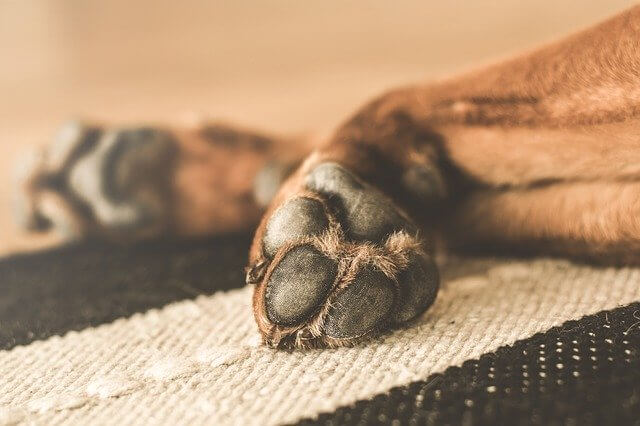 Soothe dryness with lotion for dog paws.
Soothe dryness with lotion for dog paws.
5. Cuts and scrapes.
First-Aid for minor injuries.
Occasionally, dogs will cut the pad of their paw and require some first aid. Clean the cut out with an antibacterial wash, put some antibacterial cream on the cut, and bandage the paw. Of course, as dog parents already know, this is easier said than done!
If the dog is unwilling to have their paw tended to, the owner should do the best they can under the circumstances. As always, seek veterinary care for any symptoms or injuries that concern you or become worse.
Watch for paw chewing.
Anxiety in dogs can manifest in the form of paw chewing. This repeated nervous biting can cause injury to paws and pads. Dogs also chew because of allergies and skin conditions. If you notice your dog chewing their feet constantly, make an appointment with the vet to see what’s got your dog feeling nervous.
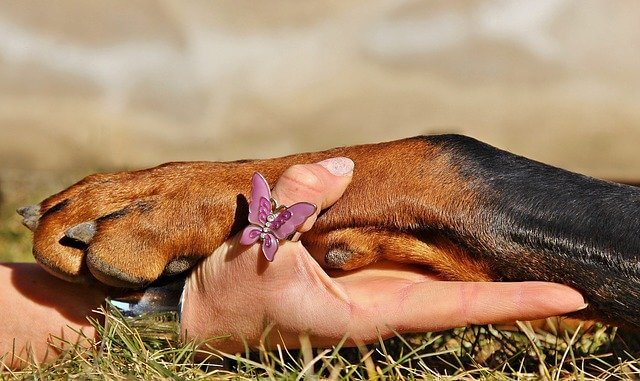
BONUS Tip: Watch Out for Hairy Paw Pads (hyperkeratosis)
More and more owners are noticing a strange phenomenon on their dog’s paw pads – small, hair-like protrusions coming from the paw pad itself (we’re NOT talking about normal hair that forms in between the toes or pads). While the condition isn’t serious in this form, it can become crusty and painful if not treated early. We’d recommend trying a paw pad balm specifically made for hyperkeratosis.

With good dog paw care, provided by a loving dog mom or dad, dogs and their feet will know years and years of happy romping!

Comments are closed.